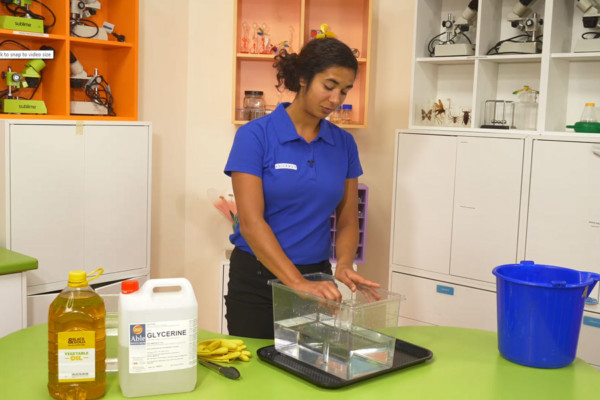
About Scitech
Scitech is a not-for-profit organisation proudly supported by the Western Australian Government through the Department of Energy and Economic Diversification
Why don't fish float to the top of water or sink to the bottom when they swim? Join Scitech presenter Ryan as we explore how fish (including sharks) maintain buoyancy.
Why don’t sharks float to the top of the water or sink to the bottom while they swim?
Join Ryan as we explore how fish (including sharks) maintain buoyancy, with some easy at home experiments.
What you’ll need:
Instructions
To start this experiment, we need to create a model of how real sharks swim in the ocean.
Take two small, evenly-sized blobs of blu tack and stick them to the bottom of each of the small containers. Stick each of the shark cut-outs to the bottom of a container.
Put the sharks in the tub of water.
Notice that the shark attached to the container of oil floats to the top, while the other shark sinks.In real life, certain species of sharks have an oily substance called “squalene” in their livers – this helps them achieve neutral buoyancy while swimming in the ocean.
Next, let’s see how other fish float in water.
Take another blob of blu tack and stick it to the bottom of the pen lid.Drop the pen lid in the jar of water and notice how it floats.
This is our model of a fish’s “swim bladder”, a gas-filled organ that helps some species of fish control their buoyancy in the water. It is the air contained in the swim bladder (or in our model, the pen lid) that counteracts the density and weight of the fish’s body (again, in our model, the blu tack).
If your pen lid doesn’t float in the jar of water, you may need to take off a little blu tack.
Next, stick your last fish cut-out to the bottom of the blu tack and drop it slowly into the bottle of water (this ensures air doesn’t escape from the pen lid).
Once the fish has been dropped in, screw on the lid to the plastic bottle.
If your pen lid doesn’t sink, you might need to:
As you’re squeezing the bottle, this increases the pressure of the water while squeezing the air inside the pen lid. This is actually what happens inside a fish’s swim bladder, as they move between different depths in the ocean.
Looking for more activities to do at home?
Upon clicking the "Book Now" or "Buy Gift Card" buttons a new window will open prompting contact information and payment details.